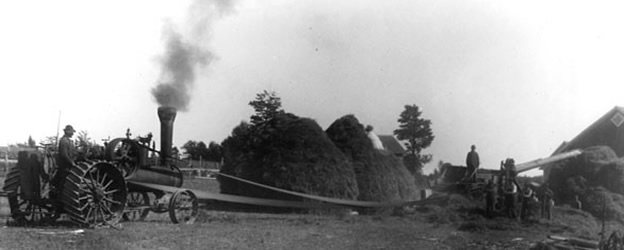Door County

The township of Jacksonport was officially organized as the fourteenth and last township in Door County on March 9, 1869. There are historical accounts of the Potawatomi Indians having a very large village known as Mechingan in the vicinity of the present center known as Jacksonport. An Indian burial ground was located behind the homes south of Eureka House (Hwy 57 & AV). It is possible the famous siege of the Ottawas by the Iroquois took place at Hibbard’s Creek.
Around the middle of the nineteenth century the first white man, Neil Blair, settled in Jacksonport. He was a commercial fisherman and farmer. Perry Hibbard moved to Jacksonport in 1861, built a dock and was in the lumbering, store and shipping business near Hibbard’s Creek. Early settlers in Jacksonport were French Canadians from Quebec arriving in the 1860s. Other immigrants settling in Jacksonport were the Canadians (Ontario) in the 1870s, and 1880s, Germans and Austrians came in the 1880s and 1890s. Families from Ireland, England, Scotland and New England as well as New York, also found land and homesteads in Jacksonport.
Families settling in Jacksonport had modest savings to pay for the low priced, undeveloped land; and they would go into debt for materials for their homes and outbuildings as well as for their farm machinery. To repay these debts many of the men would spend the winter in the woods cutting trees for cordwood or other wood products. During the long winter months they would buy food as well as other necessities "on account" at the general store. In the spring when the ships would come in to the port and load up with the lumber products that were harvested, the  families could settle their finances with the merchant. In 1877 the best cord of wood would be sold for a mere $2.40 per cord. Their tools were crude. No one had a refrigerator and a wood-burning stove was used for cooking and heating their homes. The stoves had a reservoir attached to the side to heat water for baths and washing clothes. Horses and oxen were used for their transportation and to pull their farm machinery for clearing the land.
families could settle their finances with the merchant. In 1877 the best cord of wood would be sold for a mere $2.40 per cord. Their tools were crude. No one had a refrigerator and a wood-burning stove was used for cooking and heating their homes. The stoves had a reservoir attached to the side to heat water for baths and washing clothes. Horses and oxen were used for their transportation and to pull their farm machinery for clearing the land.
Commercial fishing was an important industry as well as lumbering in Jacksonport. Trout and whitefish were plentiful in the early days, being marketed as fresh or salted fish. The fish were caught in gill nets, and packed in wooden kegs. At one time there were ten commercial fisheries in Jacksonport.
During the 1870s there were two general stores, a meat market, and two blacksmith shops. There were two wagon shops, a saw mill, two hotels, taverns and also a boarding house. Sailing vessels, as many as 39, would come to the piers to be loaded with wood products to be taken to market.
Very few doctors were in the county and were called only in an emergency, as it would be  necessary to drive fifteen miles to Sturgeon Bay, on dirt roads that were very rough and many times impassable with only one track. Home remedies were their medicines and a midwife delivered their children.
necessary to drive fifteen miles to Sturgeon Bay, on dirt roads that were very rough and many times impassable with only one track. Home remedies were their medicines and a midwife delivered their children.
Jacksonport had four school districts in their township, until their consolidation with Sevastopol schools in the late 50s. Jacksonport, District One; Farview, District Two; Groveland, District Three, and Washington District Four. Between 1874 and 1888, Catholic, Methodist, Episcopal and Lutheran churches were established in the township of Jacksonport.
By 1890 the township of Jacksonport was almost all agricultural, with lumbering being done on a very small scale. It was about the turn of the century that outsiders discovered the Jacksonport area as a great vacation center. Some stayed at the Eureka House or LaMere Lodge and other camped and lived in tents. By the 1920s cottages were being built and rented to the vacationers.
Currently the Jacksonport fishing piers and docks are gone, no commercial fishing is done and boarding houses are outdated. Farms are getting bigger and fewer. When you drive through the village or our rural countryside you can still see a few old buildings (as if it were yesterday); a combination of new and very old. Jacksonport is a unique town.



